There are as many reasons to be in Barcelona as there are passions one can hold in Barcelona, alongside books.
A visit to Camp Nou, the home stadium of FC Barcelona, is probably one rite of passage for newly arrived (permanent) residents to the city. Watching Barcelona play SD Eibar at Camp Nou last season, at what was admittedly a quite low-key match (far from being ‘el clásico’), demonstrated the fervent passion held for the city’s football team. There were no large gaps of empty seats to be seen in the stadium (seating capacity 99,354). Indeed, to a novice supporter, it seemed pretty full. The very long orderly queue to get into one of the nearby metro stops at the end of the match was also testament to the volume of Barcelona supporters present.
And so, it was with some first-hand interest that I picked up a small batch of eight FC Barcelona Information Bulletins (small folio, 305 x 220mm) as an interlude to cataloguing in Gemma’s bookshop. Dating from 1954 to 1956 the main theme running throughout, apart from the many positive aspects of the Barcelona team, was the plan to construct a new home stadium – the present Camp Nou.
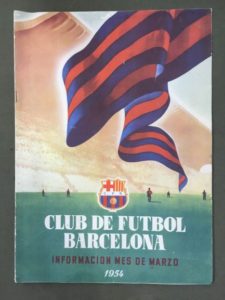
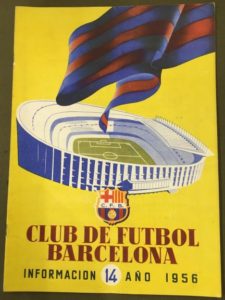
The story they tell begins with the 18 February 1954 press conference announcing the construction of a new “campo” for the team. Making the announcement was the relatively new President of the Club de Futbol Barcelona (as it was officially called at the time), Francesc MIró-Sans, who had based his campaign to be President upon the building of a new stadium.
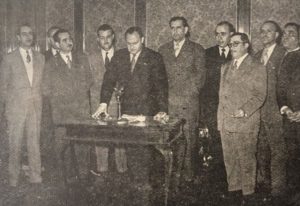
Also covered in detail, with photos, is the laying of the foundation stone for the new stadium (28 March 1954) to be constructed in the “las Corts” district of Barcelona, in the “zona de La Maternitat” (maternity hospital). The quantity of persons (60,000) attending such a symbolic act, as opposed to a very visual event, was impressive. As was the plethora of religious and other banners ‘flying’ (it was a Sunday!). It is a testament to positive cohabitation that, despite the proximity to what is the world’s third largest football stadium, La Maternitat hospital still today sits side by side with Camp Nou.
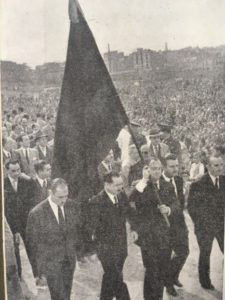
Bulletin no. 4, 1954, gives details of the plans for the new stadium which was designed to hold 149,720 spectators when completed – 89,598 standing and 60,122 seated. By comparison Barcelona’s then existing stadium could hold 48,000 spectators. For such an ambitious and also expensive project the no. 10 1955 Bulletin found it necessary, in order to calm doubts perhaps, to give a positive answer to the rhetorical question is the plan “una utopia”? Clearly, as it turned out, it was not. However the club was left with a considerable gap, and eventual deficit, in the construction costs.
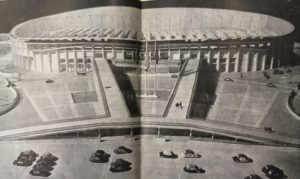
Support for the plan, not just from individual ticket paying fans, is evidenced in the Bulletins with copious references to the political institutions and authorities who were present, or represented at, the various official stadium development events. Given the dictatorial regime governing Spain at the time, the most symbolically important support was that of the Head of State (Generalísimo Francisco Franco). This was marked with the presentation to Franco, by the club hierarchy, of a miniature reproduction of the new stadium, which is featured in the no. 11 Bulletin of 1955.
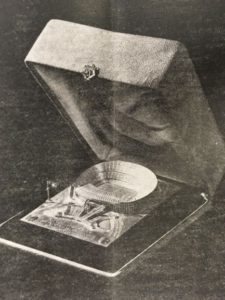
The presentation took place on 14 October 1955 at the Palau (Palacio) de Pedralbes, Franco’s residence during his visits to Barcelona.
I am unqualified on many counts to explain the historical realities, and political and cultural sensitivities, surrounding this episode both then and now. I would just draw attention to the fact that a month after the beginning of the Spanish Civil War (July 1936 to April 1939), Barcelona’s then club President Josep Sunyol had been murdered by Franco’s soldiers on 6 August, 1936. The club became and remains part of the symbolism of Catalan identity, an identity effectively suppressed under Franco. Today, as the match clock ticks to 17 minutes and 14 seconds into every Barcelona home game at Camp Nou, one can hear cries of ‘Independencia’ around the stadium – 1714 being the year when Catalan troops were defeated by the Spanish army.
The final Bulletin in the series of eight leaves us, in football terms, on very familiar turf. A small report refers to the visit of British public works contractors to the development site for the new stadium to see what they could learn.
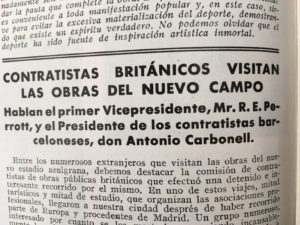
And thus a precedent of sorts is set for the exchange of skill and know-how of a different type – that of players and managers between one of the world’s iconic football teams and the “beautiful game” as played in the English football league.